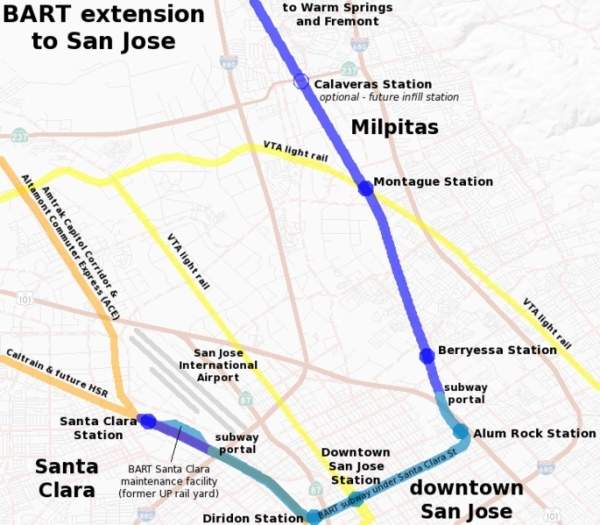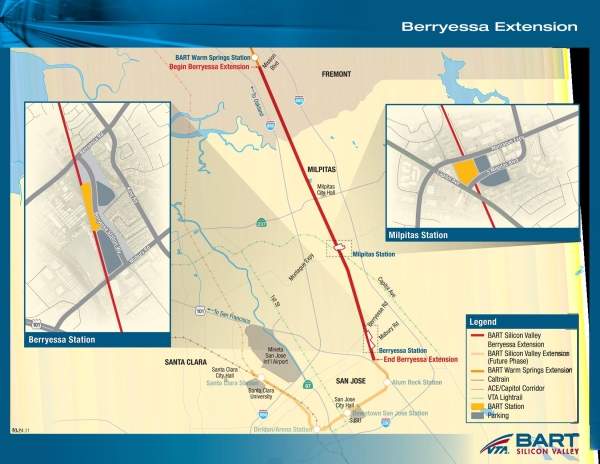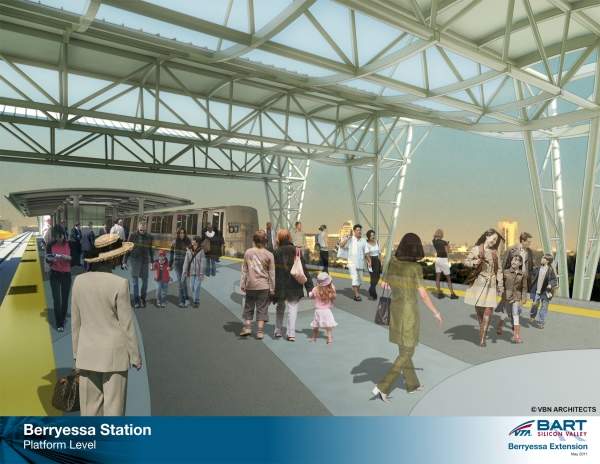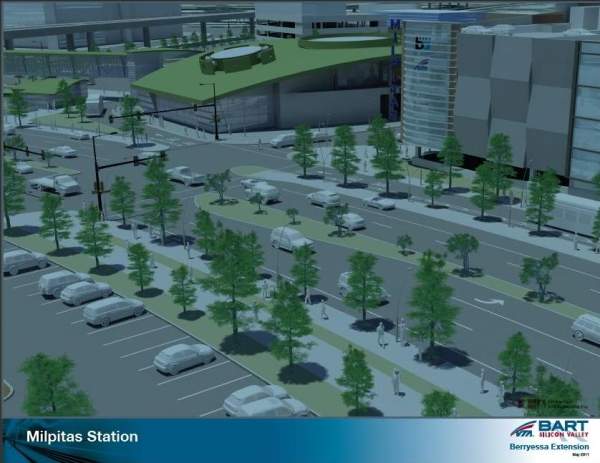Bay Area Rapid Transit (BART) Silicon Valley is a planned 16-mile extension of the existing BART regional heavy rail system to San Jose, Milpitas and Santa Clara, California, US. The project is being delivered in phases, and construction on the first phase began in April 2012. The first phase of BART expansion is scheduled to be opened for passenger service in 2017.
This extension of the regional BART rail system was designed and is being built by the Santa Clara Valley Transportation Authority (VTA). It will be operated and maintained by BART. Nearly 5,500 jobs will be created during the construction of the line, track, systems and stations. An additional 4,000 indirect jobs will result from activities related to the contract, while 3,800 more jobs will support construction of the station campus areas, access roadways, parking structures and transit centres.
BART Silicon Valley routes
The 16-mile BART Silicon Valley extension will connect Santa Clara County to the existing 109-mile BART system, as well as Oakland and San Francisco. It will include a five-mile tunnel underneath downtown San Jose.
The northern section of the line will follow the Union Pacific railroad alignment south of the future Warm Springs station in Fremont. It will serve San Jose State University, Santa Clara University, HP Pavilion, Mineta SJ International Airport, and other education and shopping centres.
Details of the extension project
The BART extension project was planned in the late 1990s to provide a transit alternative to the highly congested I-680 and I-880 commute corridors and connect San Jose with the rest of the San Francisco Bay area. Santa Clara County voters approved a 0.5¢ sales tax in 2000 to fund the project. An additional 0.8¢ sales tax measure was passed in 2008 to fund operations and maintenance of the extension.
The BART extension will provide alternate transit options, reduce traffic congestion and eliminate approximately 16,000t of greenhouse gases in a year. It will also provide support for the development along the corridor.
Infrastructure and construction
The first ten-mile phase, the Berryessa Extension, begins at the future Warm Springs station in Fremont, and includes two stations, one in Milpitas and one in the Berryessa area of north San Jose.
One of the first activities performed by the design-build team was the completion of final design of the line, track, systems and stations. Full construction began by mid-2012. The two stations will feature parking structures, bus transit centres, and bike and pedestrian connections. Construction on the first phase is expected to be complete by 2016, and it is scheduled to open for train operations soon after.
Project development activities continue for the second six-mile phase, which will include construction in downtown San Jose and Santa Clara. The second phase includes an 8km tunnel under Santa Clara Street in downtown San Jose, and a terminus in Santa Clara near the Caltrain station. Securing funding for the remaining six miles is a key project development activity for that phase.
Contractors
The Skanska-Shimmick-Herzog joint venture was awarded a $772m design-build contract in December 2011. The scope of work includes construction of the line, track, systems and stations for the ten-mile Berryessa Extension.
As part of the corridor preparation activities, a $22.14m contract was awarded to Gordon N Ball in September 2011 for the construction of the Kato Road Grade Separation in Fremont. The work involved separating Kato Road from the Union Pacific Railroad (UPRR). Construction took 18 months to complete by early 2013.
Financing
The total estimated cost for the 16-mile Silicon Valley Project is approximately $6bn. The ten-mile, first-phase Berryessa Extension is expected to cost $2.3bn. Funding for the project comes from local, state and federal sources, and includes $1.4bn from the 2000 Measure, $352m from the State of California and its Traffic Congestions Relief Program (TCRP), and the remaining $900m (38%) from a federal grant through the New Starts Program. The VTA executed a full-funding grant agreement for the $900m New Starts federal grant in March 2012.











